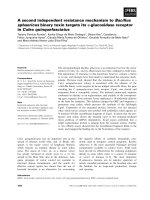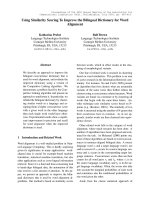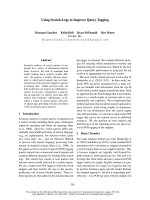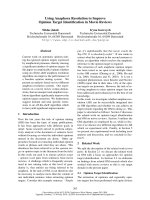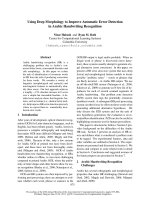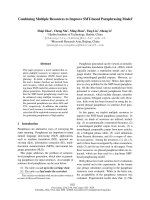báo cáo khoa học: "A trial platform to develop a tailored theory-based intervention to improve professional practice in the disclosure of a diagnosis of dementia: Study protocol [ISRCTN15871014]" potx
Bạn đang xem bản rút gọn của tài liệu. Xem và tải ngay bản đầy đủ của tài liệu tại đây (237.29 KB, 6 trang )
BioMed Central
Page 1 of 6
(page number not for citation purposes)
Implementation Science
Open Access
Study protocol
A trial platform to develop a tailored theory-based intervention to
improve professional practice in the disclosure of a diagnosis of
dementia: Study protocol [ISRCTN15871014]
Martin P Eccles*
1
, Robbie Foy
1
, Claire H Bamford
1
, Julian C Hughes
3
,
Marie Johnston
4
, PaulaMWhitty
1
, Nick Steen
1
and Jeremy G Grimshaw
2
Address:
1
Centre for Health Services Research, University of Newcastle upon Tyne, 21 Claremont Place Newcastle upon Tyne, UK,
2
Ottawa Health
Research Institute, Ottawa Hospital, Ottawa, Canada,
3
Northumbria Healthcare NHS Trust, North Tyneside General Hospital, Rake Lane, North
Shields, Tyne and Wear, UK and
4
School of Psychology, University of Aberdeen, William Guild Building, King's College Aberdeen, UK
Email: Martin P Eccles* - ; Robbie Foy - ; Claire H Bamford - ;
Julian C Hughes - ; Marie Johnston - ; Paula M Whitty - ;
Nick Steen - ; Jeremy G Grimshaw -
* Corresponding author
Abstract
Background: For people with dementia, care should include an explanation of the diagnosis to
individuals and their carers, and information about the likely prognosis and possible packages of
care. However, this is neither routine nor inevitable, and there is wide variation in the practice of
disclosure. The aim of this study is to develop a tailored theory-based intervention to promote
appropriate disclosure of diagnosis of dementia.
Methods: There are three objectives. Objective 1 is to define and develop an appropriate model
of disclosure; this will be addressed using a multidisciplinary consensus development process.
Objective 2 is to identify factors that influence disclosure of diagnosis; a questionnaire based upon
theoretical constructs from a range of behavioural theories will be developed and members of old
age mental health teams will be surveyed. The analysis will identify those factors that best predict
intention to disclose a diagnosis to a person with dementia. Objective 3 is to develop and pilot test
a theory-based intervention to promote disclosure of diagnosis that targets attitudes, beliefs and
actions most amenable to change. Objective 3 will use the results of Objectives 1&2 to design and
pilot test an intervention to improve the process of and increase the proportion of individuals
receiving a diagnosis of dementia, for members of old age mental health teams. This work will lead
to a proposal for a randomised controlled trial of the intervention.
Background
Approximately 600,000 people in the UK have dementia.
This is 5% of the population aged 65 and older, and 20%
of those aged 80 and older [1]. By 2026 this figure is pre-
dicted to be 840,000. Dementia is associated with major
social and economic costs, including those to families and
carers. The UK National Service Framework (NSF) for
Older People states that the improved care of people with
dementia depends on early recognition and management
[1]. Such care should involve a sensitive and accurate
explanation of the diagnosis to individuals and carers,
Published: 31 March 2006
Implementation Science 2006, 1:7 doi:10.1186/1748-5908-1-7
Received: 21 December 2005
Accepted: 31 March 2006
This article is available from: />© 2006 Eccles et al; licensee BioMed Central Ltd.
This is an Open Access article distributed under the terms of the Creative Commons Attribution License ( />),
which permits unrestricted use, distribution, and reproduction in any medium, provided the original work is properly cited.
Implementation Science 2006, 1:7 />Page 2 of 6
(page number not for citation purposes)
and information about the likely prognosis and possible
packages of care.
Appropriate disclosure of a diagnosis to individuals with
dementia is important for three reasons. First, from an
ethical perspective, people with dementia, like other
patients, have a right to know their diagnosis. At present,
most carers are told the diagnosis [2], but this is not the
case for people with dementia themselves [3]. Indeed, dis-
closure is less likely in dementia than in other terminal
conditions, such as cancer. Earlier disclosure, supported
by advocacy groups, allows the opportunity to plan fam-
ily, financial, legal and long-term care arrangements. Sec-
ond, many people with dementia want to know their
diagnosis or receive more information about their illness
[4-6]. Third, disclosure can facilitate decisions about treat-
ment. Whilst this is increasingly important in the advent
of therapies to slow disease progression, anecdotal evi-
dence suggests that patients prescribed anti-dementia
medication are not inevitably told their diagnosis. The UK
Alzheimer's Society Consumer Network has identified
issues around early diagnosis and care as research priori-
ties.
It is a consistent finding that changing clinical practice is
unpredictable and can be a slow and haphazard process.
Over the last decade a considerable body of literature has
been published suggesting that a range of interventions
(e.g. reminder systems, interactive education) can be
effective in changing health care professionals' behaviour
[7]. However, studies have substantial heterogeneity of
interventions used, targeted behaviours, and study set-
tings that make generalising their findings to routine
healthcare settings problematic. Moreover, there is no
underlying generalisable taxonomy for either research or
service settings by which to characterise individuals, set-
tings and interventions. The assumption that clinical prac-
tice is a form of human behaviour and can be described in
terms of general theories relating to human behaviour
offers the basis for a taxonomy for Implementation
Research. For example, the effectiveness of interventions
may be influenced by factors such as health professionals'
beliefs or perceived control over their practice – generalisable
concepts that can be used across different contexts. Two
steps are necessary to design a theory-based intervention
for a behaviour change trial [8]. One is to identify modifi-
able factors underlying professional behaviour in order to
identify those processes to target with an intervention
(process modelling), and the second is to understand how
interventions might work and be optimised (intervention
modelling). These respectively correspond to the theoret-
ical phase and the modelling and exploratory trial phases
of the UK Medical Research Council (MRC) Framework
for the development and evaluation of complex interven-
tions [9,10].
Work conducted to date
In the clinical area of dementia we have conducted a sys-
tematic review that indicates wide variation in the
reported practice of disclosure of dementia among health
professionals [3]. Four main factors appear to influence
disclosure: (1) patient characteristics (e.g. age, ability to
retain the diagnosis); (2) nature of the dementia (e.g.
severity, diagnostic uncertainty, availability of disease-
slowing therapies); (3) structural factors (e.g. time); and
(4) clinician factors (e.g. perceived value of disclosure)
[11-19]. We have conducted a detailed primary and sec-
ondary care case note review to look for symptoms that
would allow the earlier diagnosis of dementia. We also
have conducted focus groups and in-depth interviews
with a range of health professionals, carers, and people
with dementia [20]. These suggest potential ways of
improving current practice and highlight the importance
of the process of referral and testing in preparing people
with dementia and their carers for a diagnosis.
In the area of Implementation Research we have con-
ducted several pragmatic RCTs of behaviour change strat-
egies and have conducted both process and intervention
modelling studies. Although these methods are familiar to
psychology, their use with healthcare professionals and
their integration into implementation trials is novel. We
will use these methods to develop an optimised, theory
based intervention – targeting modifiable factors – to
increase diagnostic disclosure of dementia. This work will
lead to a randomised controlled trial of the intervention.
Aim
To develop a tailored theory-based intervention to pro-
mote appropriate disclosure of diagnosis of dementia.
Objectives
(1) To define and develop an appropriate model of disclo-
sure for dementia; (2) To identify, within a theoretical
framework, factors that influence disclosure of a diagnosis
of dementia by members of old age mental health teams
(MHTs); (3) To develop a theory-based intervention that
promotes appropriate disclosure by targeting those factors
identified in (2) that are amenable to change.
Methods
Objective 1: Defining an appropriate model of disclosure
for dementia
Disclosure is ideally a process tailored to individuals'
receptiveness and needs for information. A group of ten
relevant stake-holders (i.e., psychiatrists, community psy-
chiatric nurses, patient group representatives, general
practitioners) will be convened and will use a structured
consensus method [20] to define an appropriate model of
disclosure, including consideration of both positive and
negative effects. This will be informed by: available docu-
Implementation Science 2006, 1:7 />Page 3 of 6
(page number not for citation purposes)
ments (e.g. NSF for Older People [1]), findings from our
qualitative work [18], further interviews with people with
dementia and two carer focus groups, and a request for
examples of good practice in the Alzheimer's Society
national newsletter.
Objective 2: To identify, within a theoretical framework,
factors that influence old age mental health teams'
disclosure of a diagnosis of dementia
Design
Postal questionnaire survey.
Study sample
Disclosing a diagnosis of dementia is predominantly the
responsibility of a consultant old age psychiatrist,
although a range of other team members contribute to the
process. We will identify involvement in disclosure within
the postal questionnaire survey (below) of old age MHT
members. This survey will also permit assessment of the
feasibility of identifying and surveying MHT members.
There are about 420 old age MHTs in the UK, and they will
have differing structures and working patterns. For Objec-
tive 2, we will sample the 60 MHTs in the North of Eng-
land and Yorkshire, and another 60 randomly selected
from the rest of the UK. The former will be subsequently
approached for recruitment to the RCT; the latter will pro-
vide data about the generalisability of the planned trial
participants.
Theory selection
The theories (Theory of Planned Behaviour (TPB), Social
Cognitive Theory (SCT) and Implementation Intentions
(II)) have been chosen for three reasons. First, they have
all been rigorously evaluated in other settings. Second,
they all explain behaviour in terms of factors amenable to
change (e.g., beliefs, attitudes, and perceived external con-
straints). Third, they all include non-volitional compo-
nents that assume individuals do not always have
complete control over their actions. According to TPB, the
strength of a behavioural intention is determined by atti-
tudes towards the behaviour (in this case disclosure), sub-
jective norms based on the perceived views of other
individuals or groups (i.e. perceived social pressure); and
perceived behavioural control, encompassing beliefs
about self-efficacy (the ability to perform an action) and
wider environmental factors that facilitate or inhibit per-
formance [21]. SCT considers self-efficacy and individu-
als' goals in explaining behaviour [22]. Self-efficacy is
highly predictive of a wide range of behaviours and can be
enhanced by experience of success, observation of others'
performance, or persuasive communications. II suggests
that motivated individuals with a clear action plan are
more likely to act. IIs are both predictive and a means of
changing behaviour [23].
Questionnaire design
We will develop questions that explore constructs within
the theories. Table 1 provides illustrative examples of var-
iables, measures and items for each.
Questions for TPB and SCT will be assessed using multi-
item scales, with items rated on seven-point Likert scales.
The content of questions about control beliefs (those that
influence the ability of professionals to disclose a diagno-
sis) relating to TPB, self-efficacy and goal beliefs relating
to SCT will be drawn from existing qualitative data. Evi-
dence of II will be ascertained using open questions about
how the respondent normally discloses, which will be
coded for evidence of "action plans" to disclose.
Outcomes
We will use two measures of outcome: behavioural inten-
tion and behavioural simulation. We will measure behav-
ioural intention using standard methods, i.e. rating scales
of likelihood, frequency or agreement with statements or
questions about intention. Six clinical scenarios that vary
combinations of relevant items of patients and diagnosis
will be used to measure behaviour simulation.
Administration
Following piloting, the questionnaire will be distributed
with reminders at two and four weeks. Surveys of UK
mental health professionals with an interest in older age
in the last decade have achieved acceptable response rates
Table 1: Illustrative examples of theories, variables, measures and items
Theory Predictor variable(s) Measures Illustrative items
Theory of Planned Behaviour Attitude towards disclosure;
subjective norms perceived
behavioural control; intention
Items developed from qualitative
work [18] using standard question
formats
Attitudes – outcome beliefs: Being
given a diagnosis of dementia will be
beneficial to the patient.
Social-Cognitive Theory Self-efficacy about disclosure; goals
relevant to disclosure
Items developed from qualitative
work [18] using standard question
formats
Self-efficacy: I am confident in my
ability to disclose a diagnosis of
dementia sensitively.
Implementation Intentions Action plans for disclosure Open questions with simple coding
for presence of action plans
Have you thought about increasing
disclosure of dementia diagnosis? How
will you go about this?
Implementation Science 2006, 1:7 />Page 4 of 6
(page number not for citation purposes)
of between 73% and 88% [14,19,24-26]. Based on previ-
ous experience with theory-based questionnaires such as
this, we anticipate the response rates will be lower. There-
fore, we will offer a financial incentive of GB£20 for each
returned completed questionnaire. MHT members will be
asked to complete questionnaires independently (i.e. not
together in teams). To conform with the Data Protection
Act, we intend to identify and seek participation in the
postal survey of professionals as follows: we shall contact
the appropriate NHS Trusts and seek demographic pro-
files of local old age MHTs; we shall then send Trusts the
appropriate numbers of introductory letters (not
addressed to named individuals) and participant informa-
tion sheets for distribution to members of local old age
MHTs; when members of old age MHTs receive the letters,
they can decide whether to opt in to the survey and return
their names and preferred contact details to us in a pre-
supplied stamped addressed envelope; we shall then send
out survey questionnaires to those who have opted in.
Under this plan, we should be able to identify our sample
denominator (to allow calculation of response rates and
sample representativeness), and send reminders and
financial incentives to those who have opted in (so as to
enhance our response rate).
Sample size and analysis
The analysis will allow us to explain variation in both
team and individual level behaviour. The surveys will gen-
erate at least ordinal level quantitative data. The relation-
ships between predictor (i.e. theoretical constructs and
clinical discipline) and outcome measures (behavioural
intention and simulation) will be assessed primarily using
multiple regression analysis and structural equation mod-
elling – a procedure that utilises the observed covariance
matrix. In both cases, the analysis will take into account
the hierarchical structure of the data. Power calculations
for multiple regression analysis depend on the number of
cases per predictor variable. A minimum sample size of 50
+ 8 m, where m is the number of predictor variables, is rec-
ommended for testing the multiple correlation, and 104 +
m for testing individual predictors [27,28]. We have
approximately 10 predictor variables, requiring a mini-
mum sample size of 130 per survey to test the multiple
correlation, or 114 to test individual predictors. We
intend to approach approximately 420 individuals that
make up approximately 120 mental health care teams.
This allows for a (worst case) response rate of around 50%
– and for the lack of independence of responses from indi-
viduals within a team.
Objective 3: Development and pilot test of a theory-based
intervention to promote disclosure of diagnosis by old age
mental health teams (ISRCTN 15871014)
Design and study sample
We will use the products of Objective 2 to identify the
most promising elements of a potential intervention and
then evaluate them using a randomised controlled design
with MHTs. We will use members of MHTs that have pre-
viously responded in Objective 2, and augment the sam-
ple to reach the required size by randomly sampling
within those MHTs not previously approached in Objec-
tive 2.
Identifying potential interventions
Objective 2 will identify the factors that are (a) modifiable
and (b) the best predictors of behavioural intention.
However, there will be a range of factors with these char-
acteristics, and we will need to choose those factors which,
in addition, can be modified by an intervention that is fea-
sible. Therefore, we need to choose the two or three "best
bets" (dependent on the results of objective 2) and simu-
late delivering them within a trial and examine their
effects [29-31]. In these modelling experiments, elements
of an intervention are manipulated within a randomised
controlled design in a manner that simulates a real situa-
tion as much as possible. Interim endpoints (stated
behavioural intention and simulation) are measured
rather than changes in professional behaviour or health-
care outcome. This novel approach offers experimental
control and the opportunity to vary elements of an inter-
vention in order to better understand intervening varia-
bles and the effect on different outcomes. Behavioural
intention has been incorporated into virtually all models
of health behaviour as the single best predictor of subse-
quent health behaviour. In a review of 10 meta-analyses
Sheeran demonstrated a consistent relationship between
behavioural intention and subsequent behaviour, with
intention explaining 28% of the variance in behaviour
[32]. Members of MHTs will receive (or will have
received) an initial survey as in Objective 2. Responders to
this will be randomly allocated by team to receive one of
up to three simulated interventions or a no intervention
control. They will be instructed to open the intervention
materials and then to complete a further theory-based sur-
vey as in Objective 2. Thus, we will identify the method
that is most effective at changing professionals' beliefs and
intentions. The sample size for a four-armed trial, pow-
ered to detect a difference between any two arms, is based
upon the following assumptions: MHT as the unit of anal-
ysis, the outcome variable in the form of a score for the
team, 80% power, and a type 1 error rate of 2.5% (rather
than 5% to allow for multiple comparisons). Further-
more, we are aiming to detect a relatively large effect size
of 0.8 on the basis that the modelling experiment elimi-
nates some of the sources of variability associated with a
Implementation Science 2006, 1:7 />Page 5 of 6
(page number not for citation purposes)
'definitive trial' (e.g. patient characteristics), and any
smaller modelling effect size is unlikely to translate into a
worthwhile effect in the definitive trial. Hence, we require
four groups of 30 teams (120 in total). We will survey 240
teams (excluding those from North of England and York-
shire) to allow for a 50% response rate in order to achieve
the required sample size.
Pilot of outcome measurement
We will undertake a small scale postal survey of carers and
people with dementia to help develop and pilot the feasi-
bility of collecting outcome measures using this method
in a definitive trial.
Partnerships
We will explore the scope for maximal 'buy in' by a range
of potential stakeholders. Representatives of the Alzhe-
imer's Society have been consulted over the development
of this proposal, and we aim to involve the Alzheimer's
Society directly in the development of the intervention.
The Faculty of Old Age Psychiatrists of the Royal College
of Psychiatrists has agreed to appoint a member to liaise
with us in regard to the design and conduct of the study.
Predicted outcomes and follow-on opportunities
We propose to evaluate the intervention developed within
a cluster randomised controlled trial. We will seek the par-
ticipation of MHTs in the North of England. This platform
work represents the first stage in engaging MHTs and will
provide necessary information about the feasibility and
appropriateness of the trial. Although we propose to ran-
domise MHTs, Objective 2 will help demonstrate whether
targeting MHTs, as opposed to individual psychiatrists
only, is appropriate and feasible. The trial outcomes will
include the proportion of people with dementia (and car-
ers) aware of their diagnosis, quality of information pro-
vided, use of medical treatments, and the economic
consequences of the intervention.
Ethical and other implications
The study has MREC approval. The University of Newcas-
tle operates a Good Practice in Research Code to ensure
highest standards of integrity in research.
Competing interests
The author(s) declare that they have no competing inter-
ests.
Authors' contributions
All authors contributed to the ideas and writing of this
paper. They have all seen and approved the final draft.
Acknowledgements
This project is funded by UK Medical Research Council, Grant reference
number G0300999. Jeremy Grimshaw holds a Canada Research Chair in
Health Knowledge Transfer and Uptake.
References
1. Health D: National Service Framework for Older People.
London, NHS Executive; 2001.
2. Commission A: Forget me not 2002: developing mental health
services for older people in England. London, Audit Commis-
sion; 2002.
3. Bamford C, Lamont S, Eccles M, Robinson L, May C, Bond J: Disclos-
ing a diagnosis of dementia: a systematic review. J Geriatr Psy-
chiatry 2004, 19:151-169.
4. Jha A, Tabet N, Orrell M: To tell or not to tell - comparison of
older patients' reaction to their diagnosis of dementia and
depression. Int J Geriatr Psychiatry 2001, 16:879-885.
5. Marzanski M: Would you like to know what is wrong with you?
On telling the truth to patients with dementia. Journal of Med-
ical Ethics 2000, 26:108-113.
6. Pinner G, Bouman WP: Attitudes of patients with mild demen-
tia and their carers towards disclosure of the diagnosis. Inter-
national Psychogeriatrics 2003, 15:279-288.
7. Grimshaw JM, Shirran L, Thomas RE, Mowatt G, Fraser C, Bero L,
Grilli R, Harvey EL, Oxman AD, O'Brien MA: Changing provider
behaviour: an overview of systematic reviews of interven-
tions. Med Care 2001, 39:II-2-II-45.
8. Bradley F, Wiles R, Kinmonth AL, Mant D, Gantley M: Develop-
ment and evaluation of complex interventions in health serv-
ices research: case study of the Southampton heart
integrated care project (SHIP). BMJ 1999, 318:711-715.
9. Council MR: A framework for development and evaluation of
RCTs for complex interventions to improve health. 2000.
10. Campbell M, Fitzpatrick R, Haines A, Kinmonth AL, Sandercock P,
Spiegelhalter D, Tyrer P: Framework for design and evaluation
of complex interventions to improve health. BMJ 2000,
321:694-696.
11. Vassilas CA, Donaldson J: Telling the truth: what do general
practitioners say to patients with dementia or terminal can-
cer? Br J Gen Pract 1998, 48:1081-1082.
12. Heal HC, Husband HJ: Disclosing a diagnosis of dementia: is age
a factor? Aging Ment Health 1998, 2:144-150.
13. Johnson H, Bouman WP, Pinner G: On telling the truth in Alzhe-
imer's disease: a pilot study of current practice and atti-
tudes. International Psychogeriatrics 2000, 12:221-229.
14. Rice K, Warner N, Tye T, Bayer A: Geriatricians' and psychia-
trists' practice differs. BMJ 1997:314-375.
15. Bamford C, May C, Eccles M, Bond J: Dementia: views of clini-
cians in primary and secondary care. Gerontologist 2001,
41:75-75.
16. Downs M, Clibbens R, Rae C, Cook A, Woods R: What do general
practitioners tell people with dementia and their families
about the condition? A survey of experiences in Scotland.
Dementia 2002, 1:47-58 [ />abstract/1/1/47].
17. Fortinsky RH, Leighton A, Wasson JH: Primary care physicians'
diagnostic, management and referral practices for older per-
sons and families affected by dementia. Res Aging 1995,
17:124-148.
18. Lamont S, Bamford C, May C, Eccles M, Bond J: The role of priming
networks in diagnostic disclosure in dementia. Gerontologist
2002, 42:85-85.
19. Rice K, Warner N: Breaking the bad news: what do psychia-
trists tell patients with dementia about their illness? Int J Ger-
iatr Psychiatry 1994, 9:467-471.
20. Murphy MK, Black NA, Lamping DL, McKee CM, Sanderson CFB,
Askham J, Marteau T: Consensus development methods, and
their use in clinical guideline development. Health Technol
Assess 1998, 2:.
21. Ajzen I: The theory of planned behaviour. Organizational Behav-
iour and Human Decision Processes 1991, 50:179-211.
22. Bandura A: Health promotion from the perspective of social
cognitive theory. In Understanding and changing Health Behaviour:
from Health Beliefs to Self-Regulation Edited by: Norman P, Abraham C
and Conner M. Amsterdam, Harwood; 2000.
23. Gollwitzer PM: Implementation intentions: strong effects of
simple plans. Am Psychol 1999, 54:493-503.
24. Gilliard J, Gwilliam C: Sharing the diagnosis: a survey of mem-
ory disorders clinics, their policies on informing people with
dementia and their families. Geriatric Psychiatry 1996,
11:1001-1003.
Publish with BioMed Central and every
scientist can read your work free of charge
"BioMed Central will be the most significant development for
disseminating the results of biomedical researc h in our lifetime."
Sir Paul Nurse, Cancer Research UK
Your research papers will be:
available free of charge to the entire biomedical community
peer reviewed and published immediately upon acceptance
cited in PubMed and archived on PubMed Central
yours — you keep the copyright
Submit your manuscript here:
/>BioMedcentral
Implementation Science 2006, 1:7 />Page 6 of 6
(page number not for citation purposes)
25. Clafferty RA, Brown KW, McCabe E: Under half of psychiatrists
tell patients their diagnosis of Alzheimer's disease. BMJ
1998:317-603.
26. Wolff LE, Woods JP, Reid J: Do general practitioners and old age
psychiatrists differ in their attitudes to dementia? Int J Geriatr
Psychiatry 1995, 10:63-69.
27. Tabachnik B, Fidell L: Using multivariate statistics Edited by: Tabachnik
B and Fidell L. New York, Harper Collins; 1996.
28. Green S: "How many subjects does it take to do a regression
analysis?". Multivariate Behavioural Research 1991, 26:499-510.
29. Bonetti D, Eccles M, Johnston M, Steen IN, Grimshaw J, Baker R,
Walker A, Pitts N: Guiding the design and selection of inter-
ventions to influence the implementation of evidence-based
practice: an experimental simulation of a complex interven-
tion trial. Soc Sci Med 2005, 60:2135-2147.
30. Bonetti D, Eccles MP, Johnston M, Steen N, Grimshaw J, Baker R,
Walker A, Pitts N: Guiding the design and selection of inter-
ventions to influence the implementation of evidence-based
practice: an experimental simulation of a complex interven-
tion trial. Soc Sci Med 2005, 60:2135-2147.
31. Bonetti D, Johnston M, Pitts N, Deery C, Ricketts I, Bahrami M, Ram-
say C, Johnston J: Can psychological models bridge the gap
between clinical guidelines and clinicians' behaviour? Aran-
domised controlled trial of an intervention to influence den-
tists' intention to implement evidence-based practice. British
Journal of Dentistry 2003, 195:602-606.
32. Sheeran P: Intention-behavior relations: A conceptual and
empirical review. In European Review of Social Psychology Edited by:
Stroebe W and Hewstone M. John Wiley & Sons Ltd.; 2002:1-36.


